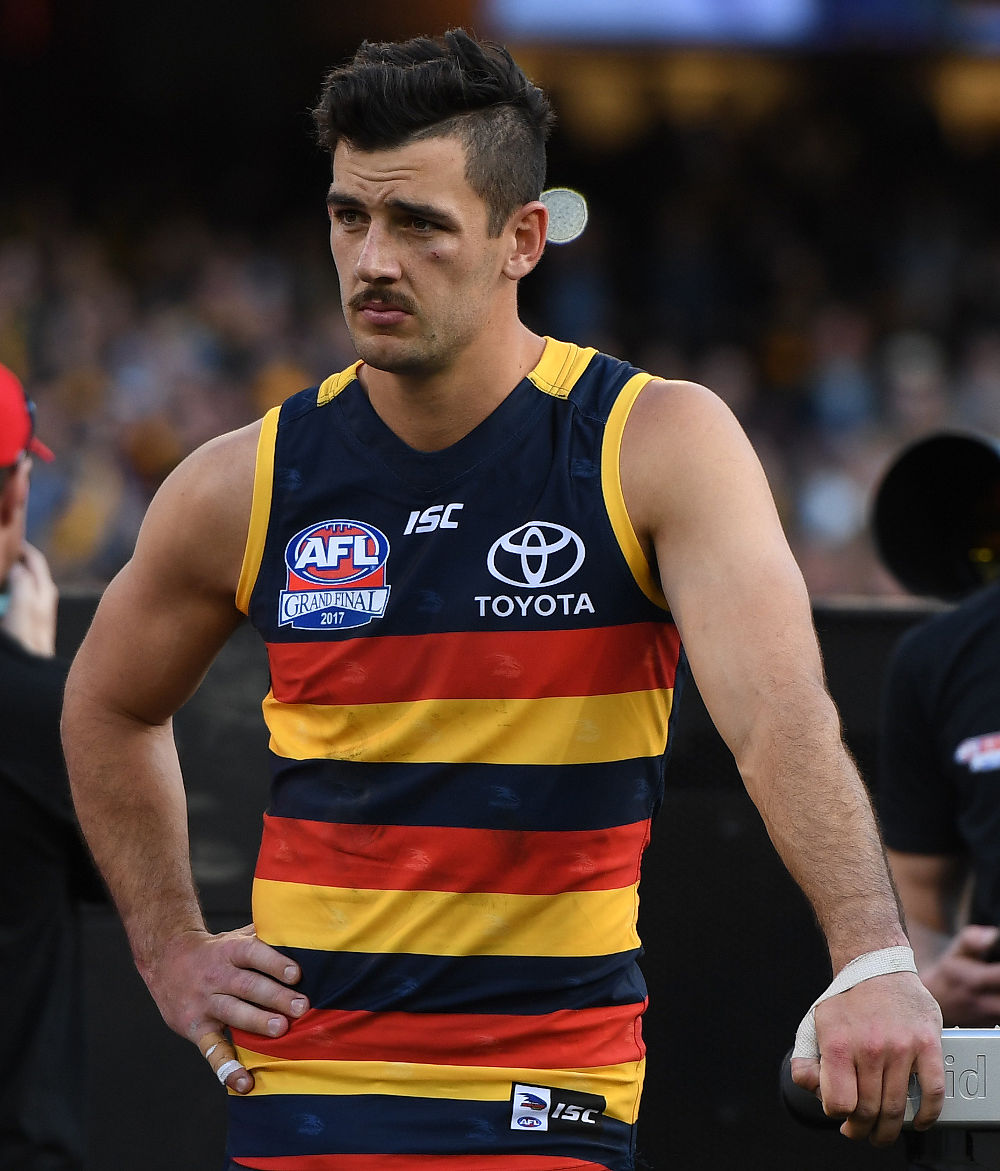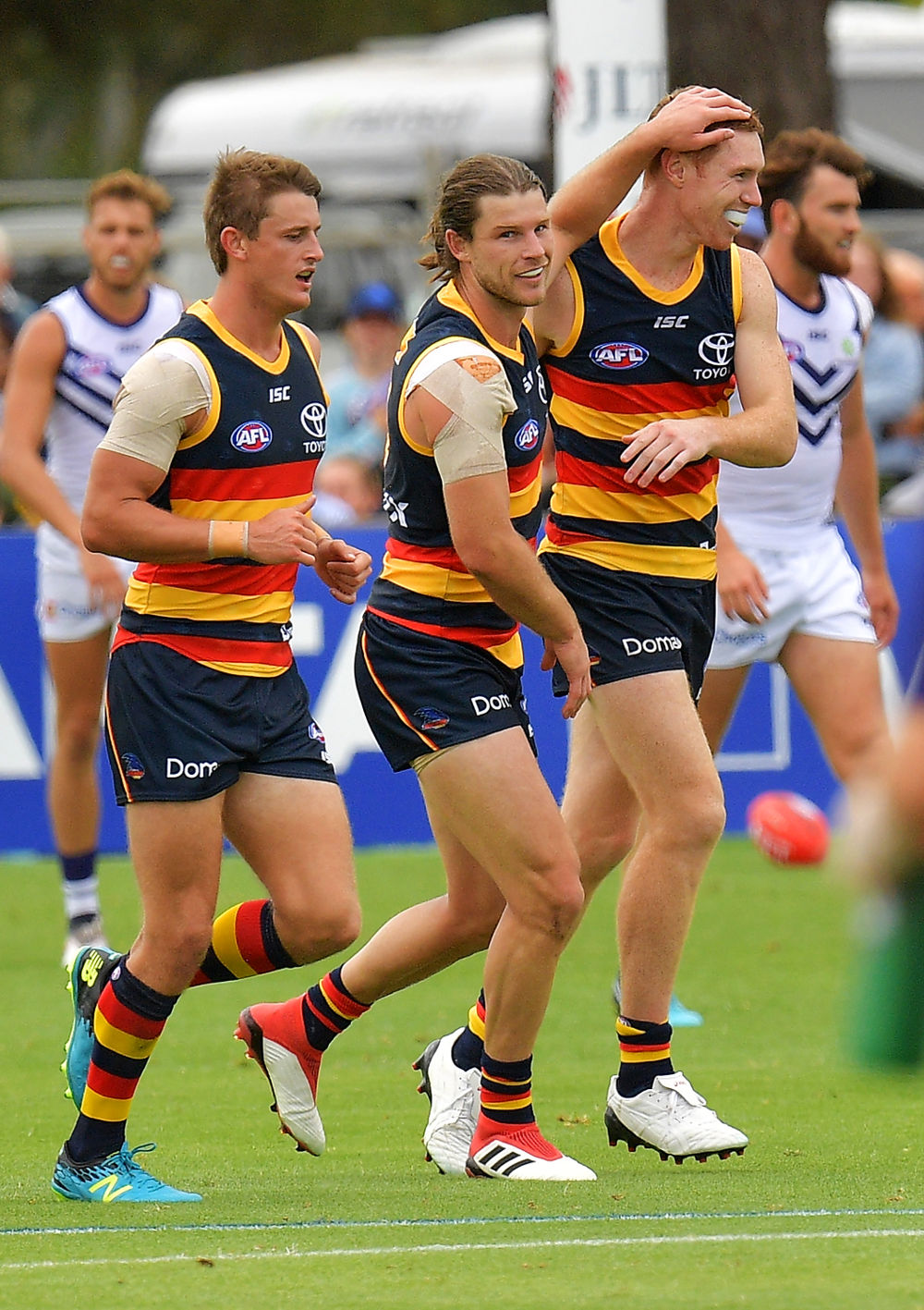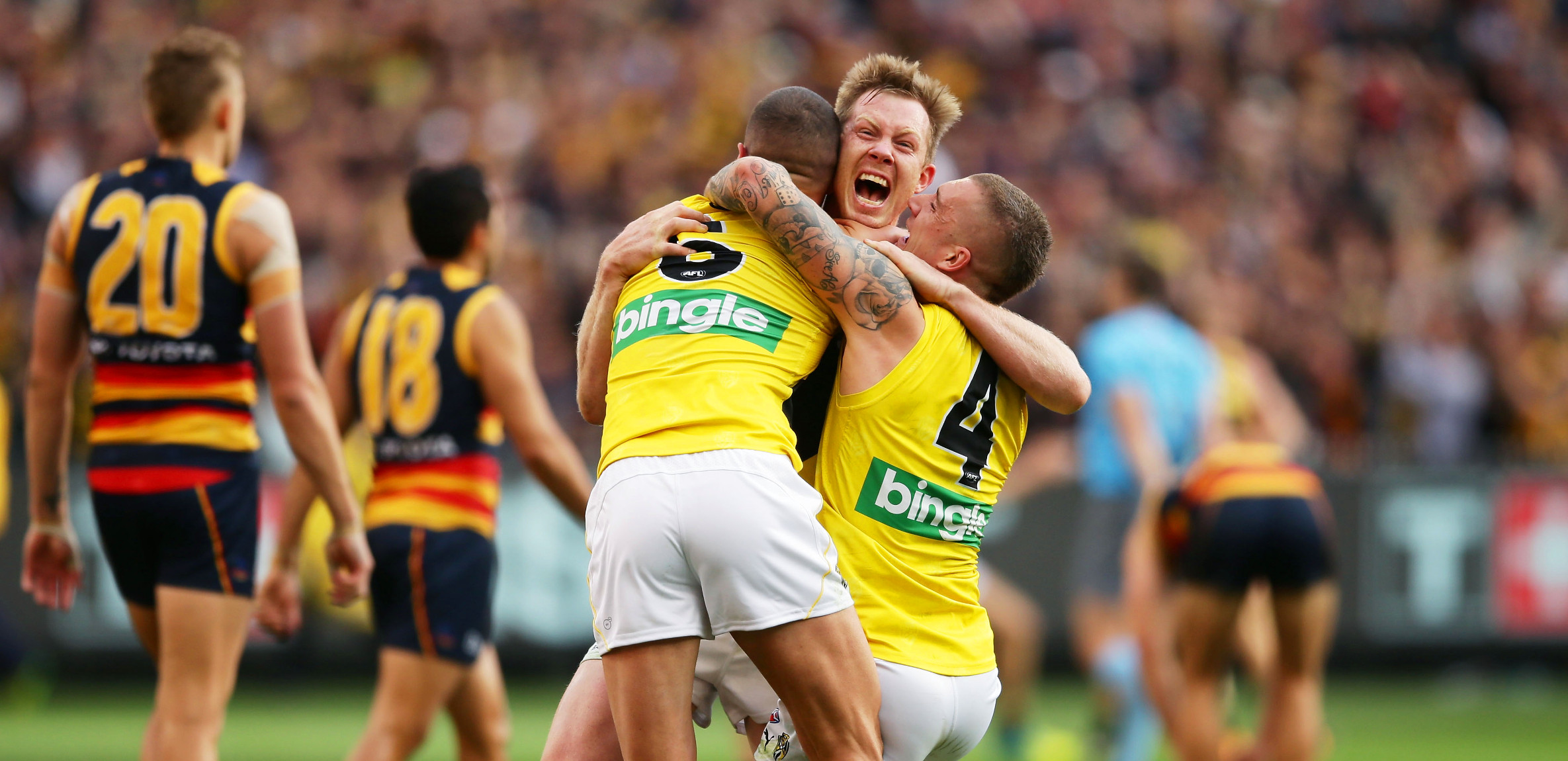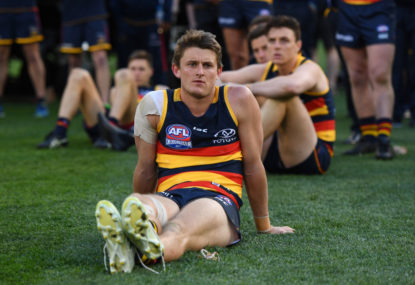For the second year in a row, the best team of the season fell at the final hurdle. For the Adelaide Crows, the manner of the defeat could define it for a decade. Or it could be a minor footnote in a storied premiership.
Almost overnight, the Adelaide Crows have earned the unwelcome title of fourth longest active premiership drought in the AFL. It has been 20 years since the Crows last won the biggest game of the year, their historic back-to-back premiership now a clear generation ago.
They’ve had a plethora of opportunities since then. A dozen finals campaigns have come and gone, with just one of them bringing more than one win. That was last year’s run, which ended the moment captain Taylor Walker adopted the team’s quirky (not a complement) power stance during the national anthem.

AAP Image/Julian Smith
Right up to that point – and it wasn’t Tex’s stance that killed them, although it didn’t help – Adelaide looked and felt like a premier. They were the stand out team in a year where there was no real stand out team in a traditional sense. The Crows finished on 15 wins and one draw, the fewest wins for a minor premier since 1997 (coincidentally, the year Adelaide won their first premiership).
What made the Crows so good, and so different, was the way the club decimated their peers. Adelaide had a net margin of 30.8 points per game against the teams ranked second to seventh; just one other club had a positive differential (Essendon, +1 points per game). It came to the fore in the Crows’ finals campaign: shellackings of both GWS and Geelong – particularly the latter.
Under the hood, Adelaide was powered by a refined offence-first scheme centred on fast counter attack to a well structured forward line. Their depth chart is stacked with rangy outside midfielders and what we’d traditionally call half back flankers, all drilled on the angles to run and kick, and the space to be in to enable the quick counter.

(Photo by Daniel Kalisz/Getty Images)
The Crows defended deep in their back 50, spending their energy on building counter attacks rather than zoning through the middle of the ground. They pressed as hard as anyone once they had the ball in their forward 50, on the relatively rare occasion that an entry didn’t lead to a score. Adelaide conceded 3.7 per cent more inside 50s per minute of opposition possession in 2017, the worst rate in the league.
That is a matter of style, not causal relevance, which is all a lot of the AFL statistics we are granted access to can tell us. Here’s another: in wins, Adelaide executed 6.8 disposals per minute of possession last season, the fewest in the league which hints at their need for speed. In losses? That cratered to 9.3, the most in the league, and the biggest differential by some way.
In equal parts, it hints at the strength and weakness at the heart of Adelaide’s system. The system that was exposed by Richmond on grand final day.
Kick in the guts
The newest left-hand side contributor Adrian Polykandrites‘ debut column as an AFL expert got me so fired up to watch the first quarter of last year’s grand final that I did exactly that. His boxing analogy was entirely appropriate, and encapsulates the game as well as any other analysis I’ve seen.
Simply, Richmond executed a defensive strategy that proved to be Adelaide’s kryptonite throughout their 2017 run. It was numbers around the ball, and a zoning scheme that dared the Crows to kick down the line rather than to the leading targets on right angles they favour.
Tigers’ coach Damien Hardwick learned this was the path to victory the hard way. Adelaide minced Richmond by 84 points in Round 6 – after which the doubters popped their heads briefly above the trenches – earning 112 more uncontested possessions and beating the Tigers at the contest by enough of a margin to take full toll. It was relentless, like a samurai slicing its way through an army of meat-headed invaders from the west.
Richmond did the opposite of what they did that day in the grand final. When the ball was in tight, it was numbers and quick hands. When it was in space, it was a kick-busting zone in the middle of the ground. When it was in Richmond’s forward 50, it was an extra mid-sized defender off the centre square at all costs, chopping off the counter attack. The results speak for themselves.
Playing the Crows this way cuts off their most potent weapon, in both attack and defence: quick ball movement. It was the question mark coming into the season, and emerged in the worst way during the biggest game of the season.

What was most shocking is the manner in which Adelaide wilted, given how well it almost always performed against the best teams of last year. That +30 point differential against 2017’s finalists is no joke, and in the main it was built on that slingshotting counter attacking style. The grand final was not the first example of this. Indeed, it shows up crystal clear looking at the data.
I’ve introduced the tackle rate statistic previously. It combines the number of tackles a team executes and the time their opponent has possession of the ball, standardised to a 50 minute rate (reflecting the average time in possession of a team).
Adelaide’s opponents had a tackle rate of 68.2 on the season, ranked eighth. In the grand final, Richmond laid 74 tackles per 50 minutes of possession. We can combine the tackle rate statistic with the ball movement pace statistic, and compare that to Adelaide’s wins and losses.
When both statistics were above Adelaide’s season average (i.e. their opponents tackled at a higher rate, and Adelaide had more disposals per minute of possession than their season average), Adelaide was 2-1-5 – five of their seven losses (including the grand final), and their lone draw, came when both conditions were met.
Taken together, the season-long success and failure in the moment should have given Don Pyke and his off field crew some pause over the off season. Adelaide were not one dimensional – they still chased and tackled, hard pressed when the ball entered their forward half, and won more than their fair share of stoppages across the ground – but it is clear their best way of playing is vulnerable to teams that plan well and execute even better.
Few teams will muster the ferocity Richmond powered itself with on grand final day on a Sunday afternoon in May. But for Adelaide, and the other band of high probability finalists, ensuring it has enough tools in its box to take all that comes in August and September.
The middle
For Adelaide, this starts in the middle of the ground. This time last year we all thought Adelaide’s weakest spot was its midfield group; plenty of flankers, a bit of pace, but light on the stereotypical ‘ballwinners’ that catch the eye and get the gaudy numbers.
The club has Rory Sloane, and at least one of the Crouch brothers would come on, but otherwise it looked a little thin. A preseason ACL tear to Cam Ellis-Yolman was met with more than the usual gusto.
Sloane went nuclear, Brad Crouch played more games than he’s every played before, Matt Crouch made the All Australian team (partially on account of Sloane’s work once he was tagged into oblivion), and the outside flankers developed a penchant for pinch hit contested ball winning they’d never really shown us before. Rory Laird took another ten steps towards the middle of the ground from his starting position as a back pocket, and suddenly the depth Adelaide was missing materialised in a matter of weeks.
To this group Adelaide has added a 29-year-old, never injured, extremely positionally versatile Bryce Gibbs. Slotting Gibbs into the line up will see him join a centre bounce crew of Sam Jacobs, Rory Sloane, Matt Crouch – relegating Brad Crouch to the bench in all likelihood, given Adelaide’s other structures forward and back – affords a top tier group that rivals any in the league. Most teams can throw out a starting quartet with two or three studs, but few have four like the Crows.
Gibbs’ arrival does more than give it a little boost at centre bounces. He can play that core role, or shift to the outside and play as a link man, or shift behind the play and run laterally as a half back, or in a pinch play on the half forward line as a threatening forward flanker. He’s potentially the key to a line up flexibility that has escaped the well-drilled Crows in the club’s recent run.
Adelaide’s high profile recruit played in his traditional centre position against Fremantle in the club’s JLT Series game against Fremantle. He had 28 touches and seven clearances, in just 75 per cent of a shorter game time.

(Photo by Daniel Kalisz/Getty Images)
There is no guarantee Gibbs plays through the middle all the time. The Crows will miss the influence of the long-kicking Brodie Smith in the defensive midfield zone, a position Gibbs could take up without much fuss. He could form a fascinating midfield-half back platoon rotation with Laird.
Shoring up the midfield will prove a useful off season activity, given there is some minor disruption at both pointy ends of the ground. The loss of Jake Lever is the loss of upside rather than an enormous downside, given he was largely a spare man defender, and the Crows have an abundance of tall defensive options. Charlie Cameron’s departure is more important, given he added a pacey line-breaking element to a forward line that is otherwise run by structural rules and regulations.
Adelaide have plenty of options here. Wayne Milera, Adelaide’s first pick in the 2015 draft, looked a lock for the spot until the rookie listed Lachlan Murphy burst onto the AFL stage in the Crows’ preseason game. Murphy’s straight line pace and quick trigger would be a useful asset if it could be harnessed regularly.
Bringing it all together
Last year Adelaide was not expected to contend for a premiership. The depth question was real, and the likes of Sydney, GWS, Geelong, and the Western Bulldogs were the fashionable choices for the flag. It didn’t take long for that veneer to fade. This year, Adelaide sits atop the premiership markets with the perennially favourite Swans.
Fundamentally, all we’ve done today is nitpick Adelaide’s ability to respond when their system is challenged. Otherwise, they look sound in every way. This will be Pyke’s third year in charge of the Crows, with 49 games under his belt as the senior coach. He knows his team. And perhaps more importantly, his team knows itself, the core having been assembled five years ago.
It enters 2018 with the second oldest and third most experienced list in the league; just two years ago the club was 13th in games played and eighth for average age. Cycles move quickly in the modern AFL.

(AAP Image/David Mariuz)
The Crows have a chance to start the year on a very strong note; games against Richmond and Sydney (home and away respectively) pocket a first seven weeks that includes games against St Kilda, Collingwood, Gold Coast and Carlton. A first up Friday night date against Essendon looks like the match of the round from here. Starting the year with five wins from seven tries looks not just possible, but likely. Anything more and the Crows would be set up for a second straight top-four finish.
Like all of last year’s top four, Adelaide holds genuine and realistic premiership ambitions. The weight of 20 years of waiting sits on the shoulders of a team built to beat the best.
But, Richmond showed Adelaide is vulnerable. Their system can be broken. Adelaide has the means to respond; the Crows’ biggest question heading into season 2018 is choosing how to respond.

































































































